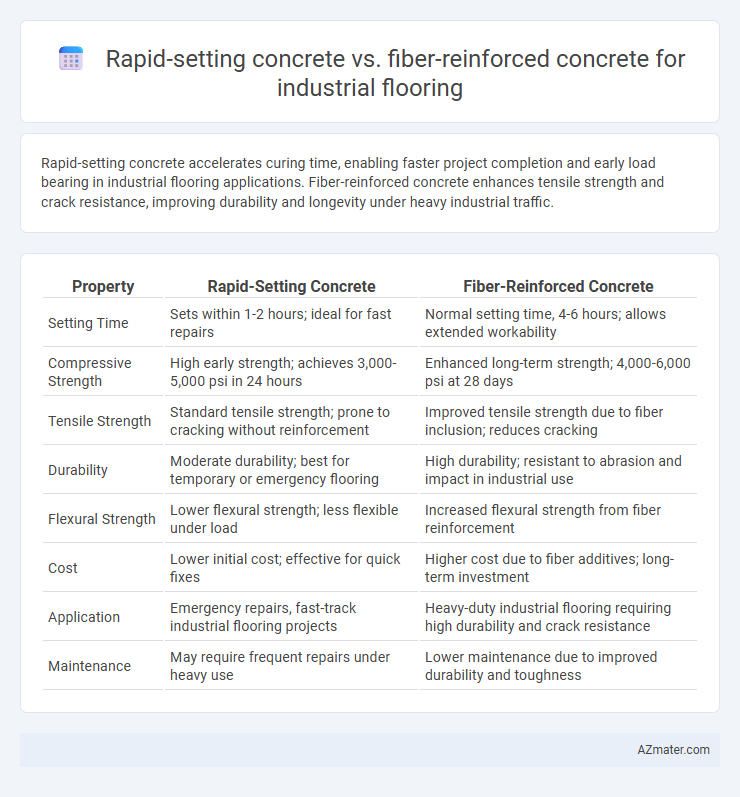Rapid-setting concrete accelerates curing time, enabling faster project completion and early load bearing in industrial flooring applications. Fiber-reinforced concrete enhances tensile strength and crack resistance, improving durability and longevity under heavy industrial traffic.
Table of Comparison
| Property | Rapid-Setting Concrete | Fiber-Reinforced Concrete |
|---|---|---|
| Setting Time | Sets within 1-2 hours; ideal for fast repairs | Normal setting time, 4-6 hours; allows extended workability |
| Compressive Strength | High early strength; achieves 3,000-5,000 psi in 24 hours | Enhanced long-term strength; 4,000-6,000 psi at 28 days |
| Tensile Strength | Standard tensile strength; prone to cracking without reinforcement | Improved tensile strength due to fiber inclusion; reduces cracking |
| Durability | Moderate durability; best for temporary or emergency flooring | High durability; resistant to abrasion and impact in industrial use |
| Flexural Strength | Lower flexural strength; less flexible under load | Increased flexural strength from fiber reinforcement |
| Cost | Lower initial cost; effective for quick fixes | Higher cost due to fiber additives; long-term investment |
| Application | Emergency repairs, fast-track industrial flooring projects | Heavy-duty industrial flooring requiring high durability and crack resistance |
| Maintenance | May require frequent repairs under heavy use | Lower maintenance due to improved durability and toughness |
Introduction to Industrial Flooring Solutions
Rapid-setting concrete offers accelerated curing times ideal for minimizing downtime in industrial flooring projects, providing early strength development and fast return to service. Fiber-reinforced concrete integrates synthetic or steel fibers to enhance durability, impact resistance, and crack control, extending the lifespan of industrial floors under heavy loads. Both solutions address specific industrial demands, balancing speed of installation and structural performance for optimized flooring systems.
Key Properties of Rapid-Setting Concrete
Rapid-setting concrete features high early strength gain, achieving structural integrity in hours rather than days, making it ideal for minimizing downtime in industrial flooring projects. Its accelerated curing process enhances resistance to wear, abrasion, and chemical exposure, which is critical for industrial environments subjected to heavy machinery and constant traffic. Unlike fiber-reinforced concrete, rapid-setting concrete offers superior rapid load-bearing capacity, allowing faster commissioning of floors without compromising durability or performance.
Core Features of Fiber-Reinforced Concrete
Fiber-reinforced concrete (FRC) enhances industrial flooring with superior tensile strength, crack resistance, and durability compared to rapid-setting concrete, which primarily emphasizes quick hardening. FRC incorporates synthetic or steel fibers that distribute stress evenly, reducing shrinkage and improving impact resistance in high-traffic industrial environments. This core feature makes fiber-reinforced concrete ideal for heavy machinery and load-bearing floors, ensuring long-lasting performance and minimal maintenance.
Strength and Durability Comparison
Rapid-setting concrete offers high early strength, allowing industrial floors to be put into service quickly, but may exhibit slightly lower long-term durability compared to fiber-reinforced concrete. Fiber-reinforced concrete enhances tensile strength and crack resistance, significantly improving overall durability and lifespan under heavy industrial loads and dynamic stresses. The integration of fibers reduces shrinkage and impact damage, making it a preferred choice for industrial flooring requiring sustained strength and resilience.
Installation Time and Workability
Rapid-setting concrete significantly reduces installation time for industrial flooring, curing within hours compared to traditional mixes, enabling faster project turnover. Fiber-reinforced concrete enhances workability by improving mix stability and reducing segregation, which aids in achieving a uniform surface finish. Combining rapid-setting properties with fiber reinforcement can optimize both speed and durability in industrial flooring applications.
Crack Resistance and Structural Integrity
Rapid-setting concrete offers accelerated curing times ideal for minimizing downtime in industrial flooring but may exhibit higher vulnerability to cracking under heavy loads without proper mix design. Fiber-reinforced concrete enhances crack resistance through the integration of synthetic or steel fibers that distribute stresses more evenly, significantly improving structural integrity and durability in industrial environments. Both materials demand precise formulation; however, fiber-reinforced concrete consistently outperforms rapid-setting variants in resisting crack propagation and maintaining long-term floor stability under dynamic industrial conditions.
Cost Analysis: Material and Labor
Rapid-setting concrete typically incurs higher material costs due to specialized additives but reduces overall labor expenses by significantly shortening curing time, enabling faster project turnaround. Fiber-reinforced concrete exhibits moderate material costs driven by fiber inclusion but often requires more labor for proper mixing and finishing to ensure uniform fiber distribution and surface integrity. Evaluating total cost for industrial flooring, rapid-setting concrete favors projects prioritizing speed and early load application, whereas fiber-reinforced concrete offers durability benefits at a balanced material and labor cost profile.
Maintenance Requirements and Longevity
Rapid-setting concrete offers faster curing times, reducing downtime and initial maintenance needs for industrial flooring, but may require more frequent repairs due to its lower long-term durability compared to fiber-reinforced concrete. Fiber-reinforced concrete enhances crack resistance and structural integrity, significantly extending the lifespan and reducing ongoing maintenance costs in heavy-duty industrial environments. The enhanced toughness and durability of fiber-reinforced concrete make it a more cost-effective option for long-term flooring solutions where minimal maintenance is critical.
Sustainability and Environmental Impact
Rapid-setting concrete minimizes downtime in industrial flooring projects by accelerating curing times, reducing energy consumption and associated emissions from extended equipment use. Fiber-reinforced concrete enhances durability and lifespan, decreasing the frequency of repairs and material replacement, which lowers long-term environmental impact. Both materials contribute to sustainable construction practices, with rapid-setting concrete optimizing project efficiency and fiber-reinforced concrete promoting structural resilience and resource conservation.
Choosing the Right Concrete for Industrial Applications
Rapid-setting concrete offers accelerated curing times ideal for minimizing downtime in industrial flooring projects, especially where quick return to service is critical. Fiber-reinforced concrete enhances durability and crack resistance by incorporating synthetic or steel fibers, making it suitable for heavy-load environments and reducing maintenance costs. Selecting between these concretes depends on project priorities such as setting time, load-bearing requirements, and long-term performance in industrial applications.

Infographic: Rapid-setting concrete vs Fiber-reinforced concrete for Industrial flooring
 azmater.com
azmater.com